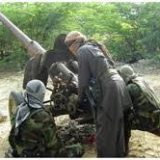Kenya Envisions a Border Wall That Keeps Shabab Violence Out
MANDERA, Kenya — As the border gate opened early in the morning, minibuses dropped off passengers, donkey-led carts trotted through and pedestrians began to cross freely on foot, heading in both directions.
The Kenyan guards standing beside the empty border offices casually watched the stream of humanity coming in and out of the country. The many family, economic and educational ties straddling both sides of the border are just too entrenched to make any real dividing line practical, many local residents say.
But the recent attacks by the Shabab, the extremist Somali group that has killed hundreds of people in Kenya in the past two years, have given rise to an ambitious national proposal that is supposed to begin right here: an enormous barrier along the 424-mile border with Somalia.
“All the problems come from that side,” said Abdi Billow, 60, a Kenyan of ethnic Somali descent from this town.
This distant northern corner of Kenya has suffered the brunt of some of the violence, including attacks on a bus of teachers over Christmas and on workers at a quarry last year, where Christians were separated from Muslims and shot.
One of the attackers in the assault on a university in eastern Kenya this month, which left almost 150 people dead, also came from here.
“A wall will go a long way in instituting some control of movement,” said Alex Nkoyo, the Mandera County district commissioner.
Kenyan officials say that construction equipment has arrived in Mandera to build what is often called a border wall but is actually envisioned as a barrier of fences, ditches and observation posts that extend from here all the way to the Indian Ocean.
“It’s not like the Great Wall of China,” said Mwende Njoka, a spokesman for the Ministry of Interior. “That would be too expensive.”
The project has stirred intense debate here in Mandera, where the two sides of the border are highly interconnected.
Bula Hawa is Mandera’s sister city, willingly or not, right across the border on the Somali side — a border that does not mean much to many residents.
Cellphone services here routinely fluctuate between Kenyan and Somali companies, and merchants go back and forth across the border. Some children from Somalia come here, where it is safer, to get a formal education, and even the district commissioner of Bula Hawa has a house in Mandera.
There is also the question of how a border barrier will address the stewing extremism among Kenyans themselves, some of whom have been implicated in deadly attacks, including the assault on the university.
“A security wall will not help,” said Ishak Aden, 60, a Somali from Bula Hawa. “The Shabab mix with the people and have a lot of spies.”
George Morara, vice chairman of the Kenya National Commission on Human Rights, said, “The war on terror must be a multi-agency, well-coordinated and intelligence-led undertaking that is capable of actively preventing terrorist attacks before they occur on Kenyan soil.”
He added, “What we need to do as a country is adopt long-term strategies aimed at creating opportunities for gainful employment for the youth who are increasingly becoming soft targets for Al Shabab’s recruitment drives.”
Mandera is a small town tucked inside the acute angle where the borders of Kenya, Somalia and Ethiopia meet. It is also the seat of a county with the same name. The area already has a curfew, from about dusk to dawn, which was imposed after the university attack this month.
Once a colonial British outpost and part of Kenya’s former North Eastern Province, its population is overwhelmingly ethnic Somali. Many shop names, written in English, are the transliterations of Somali and Arabic names.
Somalia once claimed this region as its own and supported an insurgency here in the 1960s, which the Kenyan authorities labeled the “Shifta War” — Shifta being a local word for “bandits.”
Many members of the older generation here say they once supported joining Somalia, but they have long since abandoned that idea. Today, many young people here insist on belonging to Kenya, though they complain of neglect, intimidation by the authorities and poverty.
Dawud Farah, 60, sells camels at a local livestock market, where the average price for one is close to $900. He explains that his camels follow available pasture land, grazing up to 30 miles across the border into Somalia.
“Camels will not go through gates,” he said, noting that livestock often cross the dusty line between the two countries where there are no border gates, offices or guards.
But Abdullah Mohamed, 51, another businessman, begged to differ. “I want the wall,” he said. “Gunmen come from the other side, hit and run away. My relatives were killed.”
At another market, Zeinab Hassan, 45, a divorced mother of three, crosses the border into Mandera to buy stacks of khat, a leaf chewed as a stimulant, and sells them back in Bula Hawa. “We don’t want the wall,” she shouted.
But Rubaba Mohamed, 50, a widow and mother of nine, also from Bula Hawa, said she supported the idea of a wall, as long as crossing was still an option.

Kenyan security officials control only limited areas of the 424-mile border with Somalia. Credit Will Swanson for The New York Times.
“Security is bad,” she said. “As long as I can buy my khat and sell it, I don’t care.”
Mohamed Abdi, 38, is the deputy chair of the khat market. He believes the real problem lies in corruption. “A border guard will take 50 shillings and you can pass,” he said, citing the equivalent of about 55 cents.
Known by the nickname Bush because of his support as a teenager for President George Bush’s mission in Somalia, Mr. Abdi believes that trade, including the prices of food, will suffer because of a wall.
“A bag of rice from Somalia costs 1,500 shillings,” or almost $17, he said. “There are no taxes at the border.”
But the same bag of rice from the Kenyan capital, Nairobi, Mr. Abdi said, would cost $50. “We can’t afford that.”
Somali officials on the other side of the border said they were not against the construction of the wall, but wanted more details.
“Kenya has a right to build a wall,” said Youssef Haji, an assistant to the district commissioner of Bula Hawa. “But where will the wall exactly be is the question.”
Kenyan officials in Mandera say the construction of the barrier awaits the arrival of experts to clearly mark the border.
Ali Roba, the governor of Mandera County, who said he “supports building of the wall 300 percent,” called for greater coordination between the national government and local authorities to improve security.
But even officials realize that the effectiveness of a wall has limits.
“The wall is not the ultimate solution,” said the district commissioner, Mr. Nkoyo. “Radical ideology is not passed on land but through technology.”
For some residents here, history has lessons to offer against the barrier.
“Even the wall in Germany came down,” said Mr. Farah, the camel merchant. “Why are they building one here?”
For the county governor, though, history is moving in the opposite direction.
“Desperate times call for desperate measures,” Mr. Roba said.



















